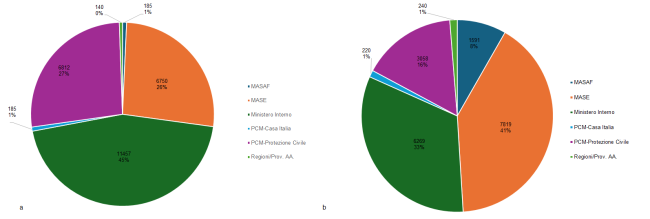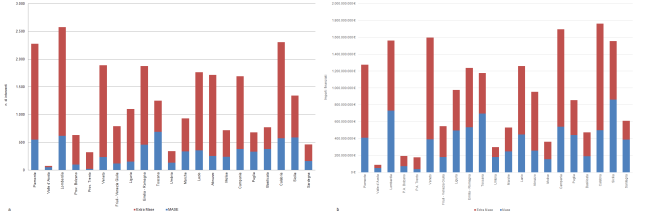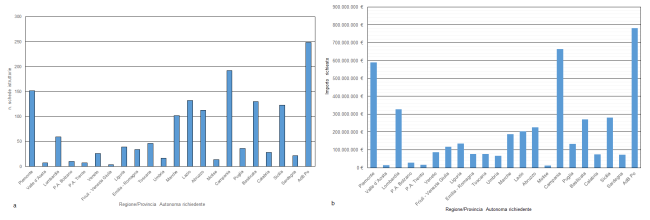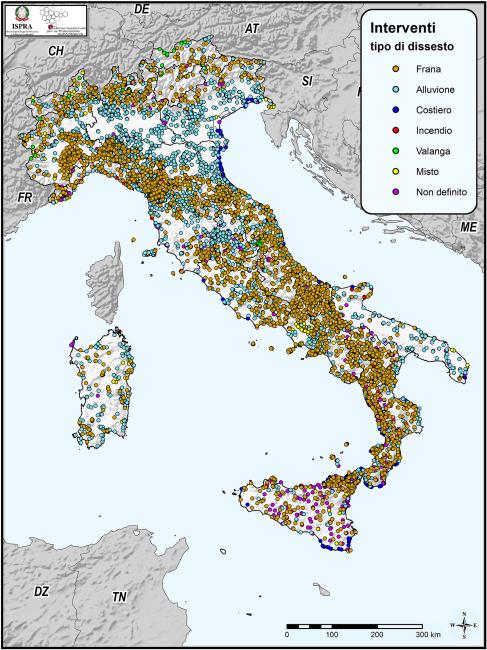Panel 1
Barbara Dessì, Francesco Menniti, Irene Rischia
The monitoring of hydrogeological risk mitigation projects funded from 1999 to December 31, 2023, by various administrations across the national territory is carried out by ISPRA through the ReNDiS platform (the Italian Repository of Hydogeological Mitigation measures). A total of 25,539 projects are recorded in ReNDiS, with a total funding amount of €19,207 million. Of these, the projects under the jurisdiction of the Ministry of the Environment and Energy Security (MASE) account for just over 26% (6,750) of the total, corresponding to approximately 41% (€7,819 million) of the total resources allocated by the other public funding administrations listed in ReNDiS. These include the Ministry of the Interior, the Civil Protection Department, the Casa Italia Department of the Presidency of the Council of Ministers, the Ministry of Agriculture, Food Sovereignty and Forests (MASAF) and the Calabria Region.
Specifically, projects under the jurisdiction of the Ministry of the Interior, the Civil Protection Department, the Casa Italia Department, MASAF and the Calabria Region represent over 73.5% (18,789) of the total number of projects, with funding exceeding 59% (€19,207 million).
Regarding the implementation status of all funded projects, 8,813 (approximately 34%) have been completed, 12% (2,951 projects) are under execution, 19% (4,836 projects) are in the design phase, while nearly 34% (8,703 projects) have yet to be started or have no reported data. The indicator also provides data on the regional distribution of projects and their classification based on the type of hydrogeological failure. Additionally, it presents data on funding requests submitted by Regions/Autonomous Provinces to MASE and the Casa Italia Department for the implementation of new hydrogeological risk mitigation projects, totaling 1,542 requests for a total project funding amount of approximately €4,440 million.
The indicator provides data on the total number, overall funding, and implementation status of hydrogeological risk mitigation projects funded between 1999 and December 31, 2023, by various central and/or local administrations, as recorded in the ReNDiS platform, which is developed and managed by ISPRA.
Additionally, as of December 31, 2023, the indicator provides the total number and amount of funding requests submitted by Regions/Autonomous Provinces via the ReNDiS platform to the Ministry of the Environment and Energy Security (MASE) and the Casa Italia Department of the Presidency of the Council of Ministers (PCM) for the realization of new hydrogeological risk mitigation projects.
The ReNDiS Monitoring Area (http://www.rendis.isprambiente.it/rendisweb) manages data related to projects funded by MASE (so-called "MASE projects") since 1999 and, starting from 2022, also includes those funded by other State Administrations ("extra-MASE projects"). These include projects under the jurisdiction of the Department for Internal and Territorial Affairs (DAIT) of the Ministry of the Interior, the Civil Protection Department, the Casa Italia Department of the PCM, the Ministry of Agriculture, Food Sovereignty and Forests (MASAF), and the Calabria Region. Information on these projects is accessible in the same way as "MASE projects" and, for technical and design aspects, can be updated directly by implementing bodies or other competent Administrations.
In contrast, the ReNDiS Evaluation Area manages the administrative procedures for financing new projects with funds allocated by MASE (under DPCM 27/09/2021) and the Casa Italia Department of the PCM.
The primary goal of the indicator is to create a unified overview of works and resources dedicated to hydrogeological risk mitigation measures, shared among all administrations involved in planning and implementing mitigation projects. The indicator enables an assessment of the distribution of allocated economic resources across the national territory, the types of projects completed, their timelines, and the financial needs for new measures based on the type of hydrogeological instability.
Thus, the indicator contributes to improving coordination among the various administrations involved in hydrogeological risk mitigation in Italy, leading to better optimization of national spending on hydrogeological risk mitigation works.
DL 180/98 as amended,
Program Agreements 2010-2011 and subsequent supplementary programs,
NP 2015-2020,
DPCM of 15/09/2015,
DL 30/2013, DD of 27/11/2017 related to Design Funds,
DPCM of 02/20/2019,
DPCM of 02/12/2019,
DPCM of 09/27/2021,
DPCM Casa Italia 2023,
DAIT Interministerial Decrees.
Panel 2
ISPRA, Ambiente in Italia: uno sguardo di insieme, Annuario dei dati ambientali 2022, “Annuario in cifre” 2020 ed Edizione 2019: Interventi urgenti per la riduzione del rischio idrogeologico”.
ISPRA (2020), Rapporto ReNDiS 2020: la difesa del suolo in vent'anni di monitoraggio ISPRA sugli interventi per la mitigazione del rischio idrogeologico. Rapporti Tecnici 328/2020.
The indicator considers, in addition to projects under MASE’s jurisdiction (MASE projects) from 1999 to December 31, 2023, those funded by other public administrations (extra-MASE projects), including the Ministry of the Interior, the Civil Protection Department, the Casa Italia Department of the Presidency of the Council of Ministers, the Ministry of Agriculture, Food Sovereignty and Forests, and the Calabria Region.
These projects have been recorded in the ISPRA ReNDiS platform only since 2022, meaning their monitoring covers a shorter time frame than those funded by the Ministry of the Environment.
A further challenge with extra-MASE projects, unlike MASE projects, is the near-total lack of technical data on project designs. The available data primarily derive from the CUP code associated with the projects, providing only administrative-accounting details, funding amounts, and geographic locations based on the municipality’s centroid.
Per migliorare la qualità dell’indicatore è auspicabile una maggiore collaborazione di tutte le Amministrazioni pubbliche competenti per gli interventi di difesa del suolo finanziati sul territorio nazionale attraverso l’invio di comunicazioni e la trasmissione di dati relativi agli interventi utilizzando l’interfaccia web della piattaforma ReNDiS.
Data quality assessment
ISPRA (Superior Institute for Environmental Protection and Research)
www.rendis.isprambiente.it
National, Regional
1999-2023
Indicator assessment
Regarding the type of data related to the measures recorded in ReNDiS, a significant difference is observed between MASE and extra-MASE ones. For the former, in most cases, administrative and financial data (such as the economic framework) and the implementation status of the measures are available, along with technical data, such as the characteristics of instability, project documentation, and geographical positioning, which in most cases is georeferenced.
For extra-MASE ones, the available data come from the Public Administration Database (BDAP) queried based on the CUP code associated with each measure. These data primarily consist of administrative and accounting information (including name and allocated funding), the implementation status, and the geographical position, which is not georeferenced but instead located at the centroid of the municipality where the mesure is carried out. No useful technical data are available, though their inclusion in the ReNDiS platform is possible but would have to be carried out by the implementing entities or the responsible monitoring administrations.
The data on hydrogeological risk mitigation measures recorded in ReNDiS show that, as of December 31, 2023, a total of 25,539 projects had been funded (Figure 1a), with a total allocated amount of €19,207 million (Figure 1b).
Of these, MASE-funded mesures account for just over 26% (6,750) of the total, corresponding to 41% (€7,819 million) of the total resources allocated by various public funding administrations for the measures recorded in ReNDiS.
Specifically, extra-MASE measures — funded by the Ministry of the Interior, Civil Protection Department, Casa Italia Department, MASAF, and the Calabria Region — represent more than 73.5% (18,789) of the total number of works, with funding exceeding 59% (€11,338 million). It is important to note that the monitoring period for these extra-MASE measures covers only five years (2019-2023), compared to 24 years for MASE ones.
A more detailed examination of measures under the jurisdiction of each of the above-mentioned administrations (Figure 2a and 2b) reveals that, despite the number of DAIT measures (11,457) being significantly higher than that of MASE works (6,750), the corresponding funding is lower (approximately €6,269 million for DAIT mesures vs. €7,819 million for MASE). This discrepancy can be attributed to:
- The shorter monitoring period is considered for DAIT
- The generally lower average cost of each DAIT compared to MASE measures.
MASE-funded programs, developed based on the planning of the relevant River Basin Authority, often involve more complex measures affecting larger areas, resulting in higher average costs.
When analyzing only MASE-funded works, comparing the number of measures and their allocated funds across the different funding groups (Table 1) highlights that:
- Measures implemented under the MATTM-Regions Program Agreements (AdP 2010-11 and subsequent supplementary acts up to 2015/2016)
- Measures under the National Plan 2015-2020 (PN 2015-2020)
These projects are characterized by higher average unit costs than those funded before 2010 (Acts and Decrees related to D.L. 180/98 and subsequent supplementary programs). This shift reflects a greater focus on strategic, large-scale projects, such as expansion basins, designed with a broader-scale planning approach (e.g., basin-scale), ensuring more efficient allocation of resources.
Further measures were planned within the National Plan 2015-2020 (PN 2015-2020), with MASE allocating approximately €1,620 million for 857 projects. This includes funding for the Metropolitan Areas Emergency Plan, aimed at 33 measures in metropolitan areas affected by flood events, with a total allocation of nearly €801 million.
From 2021 to 2023, MASE allocated an additional €853 million to fund 418 projects, divided into: Hydrogeological risk mitigation measures (annual mitigation plans for 2021-2023);
New measure planning, funded through a specific Design Fund for 2022-2023 (Table 1, Figures 1a and 1b).
Between 1999 and 2021, the indicator shows a progressive increase in the number of mesures funded for risk mitigation, accompanied by a similar trend in the allocated resources. Significant increases in both the number of measures and corresponding funding occurred following the issuance of financial Acts or Decrees related to major catastrophic events (e.g., the 2000 Soverato flood, the 2001 Liguria flood, the 2011 floods in Genoa and Sicily, the 2018 Sicily flood, etc.).
During this period, a higher ratio of allocated funds to funded measures is observed from 2010 onwards, following the MATTM-Regions Program Agreements, and from 2015 onwards, with the implementation of the 2015-2020 National Plan (PN). This increase is due to the higher average unit cost of measures compared to previous years. This trend is linked to the implementation, from 2010 onwards, of more significant strategic measures (e.g., expansion basins), covering larger areas and planned within a broader basin-scale framework. Additionally, hydraulic measures have had a greater financial impact since 2010 due to their higher unit costs compared to other types of mitigation projects.
From 2022 onwards, with the inclusion of extra-MASE measures in ReNDiS, there has been a significant and sudden increase in the number of funded measures and allocated resources, as these represent approximately 73% of the total. This has also resulted in a considerable increase in allocated funds, although at a lower growth rate, with extra-MASE financing accounting for approximately 59% of total allocated funds. This trend is attributable both to the shorter monitoring period for these measures and to the fact that the average cost of an extra-MASE project is generally lower than that of a MASE one. This is because the programs implemented by the Ministry of the Environment, based on the planning of the relevant River Basin Authority, often involve more complex measures covering larger areas, which are therefore associated with higher average costs.
Data
Riepilogo e suddivisione dei provvedimenti di finanziamento degli interventi di mitigazione del rischio idrogeologico in funzione dell’Amministrazione finanziatrice competente e dei relativi Gruppi di finanziamento (dal 1999 al 31 dicembre 2023).
Elaborazione ISPRA su dati di monitoraggio interventi per la riduzione del rischio idrogeologico riportati in ReNDiS.
Figura 1: Distribuzione complessiva del numero d’interventi e degli importi suddivisi per gruppo di finanziamento presente in ReNDiS finanziati dal MASE e con altre fonti di finanziamento pubblico (extra MASE) (1999-2023)
Elaborazione ISPRA su dati di monitoraggio interventi per la riduzione del rischio idrogeologico riportati in ReNDiS
Figura 2: Distribuzione complessiva del numero d’interventi e dei relativi importi finanziati, suddivisi per competenza delle diverse Amministrazioni che erogano le risorse per la realizzazione degli interventi censiti in ReNDiS (1999-2023)
Elaborazione ISPRA su dati di monitoraggio interventi per la riduzione del rischio idrogeologico riportati in ReNDiS
Figura 3: Distribuzione per Regione/Provincia Autonoma del numero e dell’importo finanziato degli interventi, suddivisi tra quelli di competenza MASE ed extra-MASE (1999-2023)
Elaborazione ISPRA su dati di monitoraggio interventi per la riduzione del rischio idrogeologico riportati in ReNDiS
Figura 5: Tempi medi di realizzazione degli interventi suddivisi per Regione/Provincia Autonoma. La linea rossa corrisponde al tempo medio di realizzazione di un intervento derivato per l’intero territorio nazionale
Elaborazione ISPRA su dati di monitoraggio interventi per la riduzione del rischio idrogeologico riportati in ReNDiS
Riguardo i dati relativi alla Regione Basilicata e alla Provincia autonoma di Trento, non avendo nessuna informazione utile circa i tempi di affidamento lavori, sono stati attribuiti valori medi nazionali al fine di ottimizzare il grafico rappresentato in figura.
Figura 8: Distribuzione del numero di schede istruttorie e relativi importi, inserite nell’Area Istruttorie dalle Regioni e non ancora finanziate in funzione della categoria di dissesto classificato in ReNDiS
Elaborazione ISPRA su dati di monitoraggio interventi per la riduzione del rischio idrogeologico riportati in ReNDiS











Below are the data regarding all the funded measures across the national territory and recorded in ReNDiS as of 31.12.2023. These are categorized into those under the competence of MASE and those under the responsibility of the Ministry of the Interior, the Civil Protection Department, the Casa Italia Department, MASAF, and the Calabria Region (extra-MASE interventions), considering their distribution by number and funding amount across the different Regions/Autonomous Provinces.
The total number of funded measures is 25,539, with an overall allocated amount of approximately €19,207 million.
The regional distribution (Figure 3a - distribution of the number of measures and Figure 3b - distribution of the allocated amounts) shows that, considering the various funding sources, Lombardy is the region with the highest number of funded measures (2,579), followed by Calabria (2,309), Piedmont (2,276), Veneto (1,890), Emilia-Romagna (1,874), Lazio (1,766), Abruzzo (1,716), and Campania (1,693), while other regions/autonomous provinces have a significantly lower number of measures.
If this analysis considers the division between MASE and extra-MASE, it is observed that the number of extra-MASE measures for each region/autonomous province is generally much higher than those under MASE competence, reflecting the national trend. However, when considering only extra-MASE, their regional distribution largely follows the same pattern as mentioned earlier, particularly in the eight regions with the highest number of funded measures (1,961 in Lombardy, 1,736 in Calabria, 1,726 in Piedmont, 1,654 in Veneto, 1,459 in Abruzzo, 1,414 in Emilia-Romagna, and 1,411 in Lazio).
The regional distribution of MASE and extra-MASE funding (Figure 3b), however, differs from the measure distribution analyzed above (Figure 3a). This discrepancy indicates that a higher number of funded projects in a region does not necessarily correspond to a higher total funding amount, as the financial allocation is also influenced by the type of projects carried out and the geographical extent of the areas affected.
In general, comparing Figures 3a and 3b reveals that the proportion of MASE funding relative to the total is greater than the proportion of MASE measures relative to the total number of ones. This observation can be linked to the fact that the average cost of individual MASE projects is generally higher than that of extra-MASE ones. As previously mentioned, MASE-funded mesures tend to be more complex and cover larger areas, as they are implemented according to broader strategies defined by basin-scale planning carried out by the competent District Authorities. In contrast, extra-MASE measures are typically funded at the municipal level and affect smaller areas.
Based on the total funding allocated (MASE + extra-MASE) (Figure 3b), Calabria appears to be the region receiving the highest financial resources (€1,761 million). However, it is important to note that this amount includes extra-MASE funding directly allocated by the region itself, which, as of 31.12.2023, are the only regionally exclusive measures recorded in the ReNDiS platform.
Aside from this case, Figure 3b highlights that the regions receiving the highest funding are Campania (almost €1,700 million), Veneto (nearly €1,600 million), Lombardy (€1,563 million), Sicily (€1,556 million), Piedmont (almost €1,300 million), Lazio (€1,261 million), and Emilia-Romagna (€1,238 million).
When considering only MASE-funded measures, substantial differences emerge among the top eight regions in terms of allocated funding. Sicily ranks first with the highest MASE funding (€863 million), followed by Lombardy (almost €733 million), Tuscany (€696 million), Campania (€542 million), Emilia-Romagna (€535 million), Calabria (€500 million), Liguria (€496 million), and Lazio (€447 million).
Analyzing these data in relation to the number of MASE measures highlights the case of Liguria, which, despite having a lower number of projects (154) compared to most other regions, received a substantial amount of funding (€496 million). This funding was allocated for projects aimed at mitigating flood risks in the urban area of Genoa following the flood events of November 2011.
Overall, comparing the two trends outlined above demonstrates that extra-MASE funding significantly influences the overall funding trend, as it is considerably higher than the resources allocated by MASE.
The analysis of the types of hazards for which measures have been funded—considering the total resources allocated by MASE and other public administrations recorded in ReNDiS (Figures 4a and 4b)—provides further insight into the geological, hydrogeological, and environmental issues affecting Italy. Indeed, the distribution of mesures closely reflects the major types of instability being addressed to mitigate hydrogeological risks.
Specifically, Figure 4a, which illustrates the total number of funded hydrogeological risk mitigation measures by hazard type, shows that designs for landslide-prone areas (8,035, corresponding to 31% of total ones) and hydraulic instability areas (7,032, accounting for 28%) are significantly more prevalent than those addressing other types of hazards. Together, they represent 59% of the total funded projects. Measures for mixed instability (1,012), coastal erosion (230), and avalanches (170) make up only 6% of the total.
Comparing these figures with the total funding allocated by MASE and extra-MASE based on hazard type (Figure 4b) reveals that, although the number of measures for landslide areas is higher than those for hydraulic instability, the funding allocated for hydraulic is considerably greater (€7,265 million) than that for landslide risk mitigation (€4,900 million), representing 38% of the total allocated funding. This discrepancy is explained by the higher unit costs of hydraulic infrastructure projects compared to those for landslides or other hazards. Hydraulic measures typically affect much larger areas than landslides, requiring greater investments in design, land acquisition, and construction materials. This is further supported by the fact that hydraulic works (e.g., flood expansion basins, overflow channels) have a much broader territorial and environmental impact compared to more localized landslide prevention measures, which generally involve smaller-scale works with relatively lower costs, even though they are widespread across the national territory.
A critical issue emerging from the analysis of Figures 4a and 4b is the high number of works (9,023) for which no specific type of hazard has been defined. These measures alone account for 35% of all considered projects. This issue becomes even more concerning when considering that these projects are associated with 30% of the total allocated resources, amounting to over €5,738 million.
This issue mainly stems from the different types of data available for MASE and extra-MASE measures recorded in ReNDiS. As mentioned earlier, MASE measures generally include technical data, such as the specific hazard type they address, whereas extra-MASE ones are primarily recorded with administrative and financial data, along with implementation status details derived from the CUP code and the BDAP database of the Ministry of Economy and Finance, which has been directly integrated into the ReNDiS platform since 2023. For these measures, as well as all those recorded in ReNDiS, the responsibility for updating technical data lies solely with the relevant entities or administrations overseeing the projects.
Analyzing the average implementation times for completed works as of December 31, 2023, across each region/autonomous province (Figure 5), the following definitions should be noted for a clearer interpretation of the data:
Additionally, for Basilicata and the Autonomous Province of Trento, since no reliable data were available for procurement times, national average values were assigned to optimize the graphical representation in Figure 5.
The histogram indicates that, compared to the national average work duration of 4.6 years, several regions/autonomous provinces exceed this timeframe, including Sardinia, Campania, Veneto, Lazio, Bolzano, Friuli-Venezia Giulia, and Puglia, all averaging over 5 years.
Among these, Sardinia and Campania show the longest average completion times (5.9 and 5.8 years, respectively), while Emilia-Romagna and the Autonomous Province of Trento have the shortest average implementation times (3.8 and 3.9 years, respectively).
A comparison of these data with the duration of different measure phases shows that the design phase has the most significant impact on extending the overall implementation timeframe compared to procurement and execution phases.